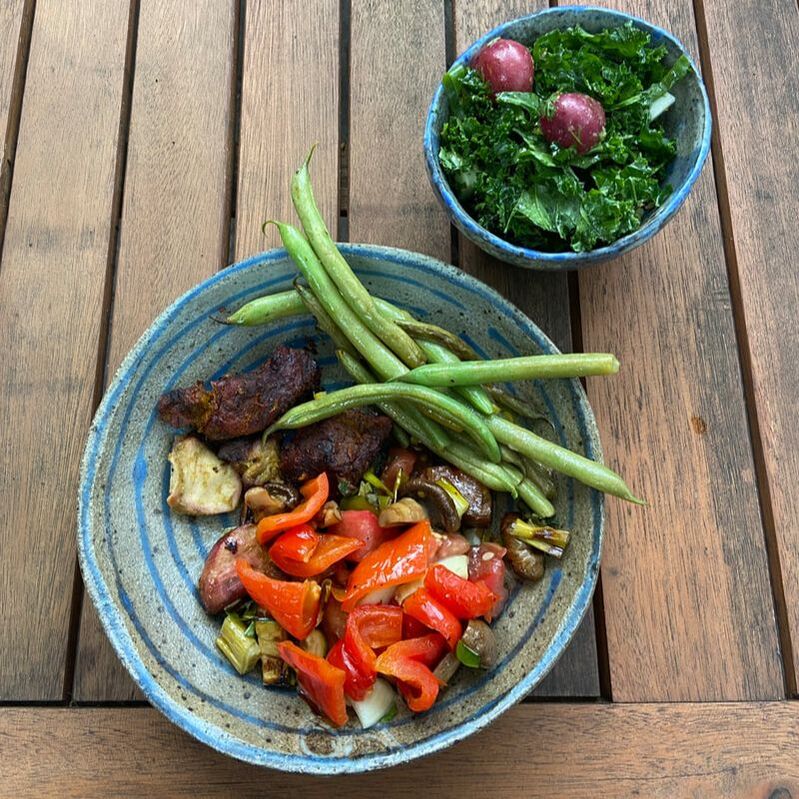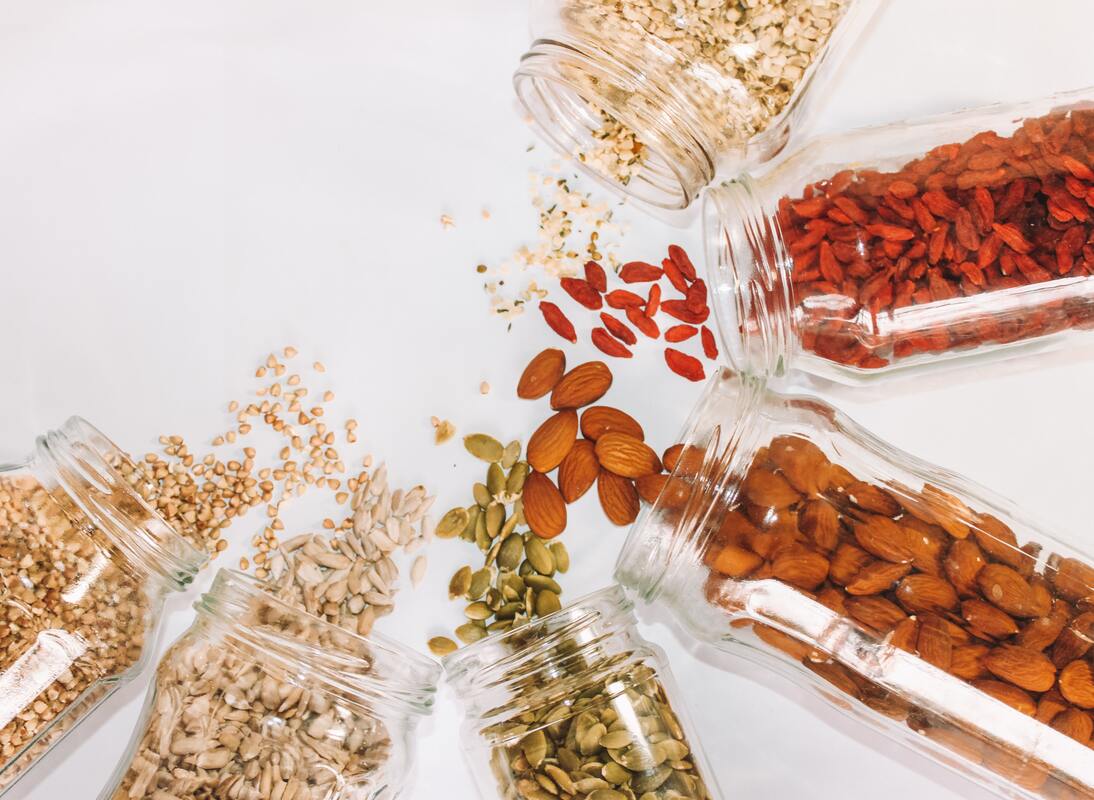|
Whether breakfast is the most important meal of the day or not, it sure seems to be the most challenging for people to look forward to. For most of my clients, breakfast needs to be quick, easy and convenient. These needs are often somewhat at odds with a lot of health goals.
My nutrition guidance around breakfast usually includes the following:
True confession: this is hard for me. I love a long, slow morning. I wake up at least 2 hours before I need to leave the house so I can bring a cup of coffee back to bed to journal and meditate (and often text excessively with my ride-or-die). It's one of my daily pleasures. And while you would think 2 hours is plenty of time to do that, eat some breakfast, get my pup out for a walk and get ready for my day, I savor the pleasure so much that I haven't been making much time for all those other things lately! TL;DR: Breakfast needs to be quick, easy and convenient for me too. Here are some tips for making breakfast work better for you. I'll follow those tips with some breakfast ideas and recipes. Include Breakfasts in Your Meal Plan One of the most obvious ways to make a good (delicious, sustaining, nutritious) breakfast happen is to plan for it like you plan for dinners and lunches. A lot of people forget to include breakfast in their meal plans - the most convenient meal is one that's already planned out! Organize Breakfast Options Sometimes the hardest part about deciding what to eat for breakfast is coming up with one idea that sounds even kinda, sorta tasty. Make it easier on yourself: keep a list. Every time you have a delicious breakfast, write it down. Writing it down could mean saving the recipe to a folder on your desktop or bookmarking it in a browser folder...whatever works for you! But save it for the day you lose all inspiration and just need a spark of "yum!" Meal Prep to Include Breakfast If you have a routine for a weekly meal prep, include breakfast. Many of the recipe and meal ideas below can be prepped ahead and reheated. What's quicker than that?! Breakfast Ideas and Recipes Here are some of my current breakfast staples and some others that have stood the test of time:
How do you make breakfast stress-free? Share your tips in the comments below!
0 Comments
What we know about nutrition changes every day. This is one of the things that makes being a nutritionist so fun and exciting - there's always something new to learn!
As an eater, who strives to do right by your body, this may also pose a challenge. It's tempting to eat the same thing day after day once you've dialed in what works for you. You find a formula that satisfies your appetite, is balanced, nutritious and doable. Why not rinse and repeat, right? It turns out that variety is not just the spice of life, it also imparts benefits to the body. Why? It's all about color! Phytonutrients are found in all plants. They are the pigments that give plants color, including anthocyanidins (blue, purple, black) and carotenoids (orange, red, yellow). They have potent antioxidant potential, helping to relieve oxidative stress that can lead to inflammation and disease. Interestingly, phytonutrients are also slightly toxic. This is actually beneficial to eaters because they gently guide and train the immune system, making it stronger and more resilient to infections and disease. Interesting stuff! The microbiome of the large intestine plays an intimate role in metabolizing phytonutrients. These chemicals are not broken down efficiently in the upper digestive tract where most nutrients are digested and absorbed. Instead phytonutrients make their way to the colon and are activated by the microorganisms there. Phytonutrients influence the microbes, encouraging a healthy immune response and reducing inflammation. In turn, the microbes transform phytonutrients into phenolic compounds that can be absorbed and used by the host/eater. It is largely accepted as truth that eating vegetables and fruits is an important feature of a healthy diet. Every client I talk to knows that the one thing they can do to improve their diet is to eat more from these food categories. That being the case, Americans tend to struggle with this dietary adaptation. Only 9% of Americans meet the USDA's recommendation of daily vegetable intake and 12% meet that for fruit. Affordable access to fruits and vegetables is a major concern in the wellness sphere. Additionally, preparation and storage of fresh produce is a barrier for many people. These concerns are beyond the scope of this article but worth mentioning as a contributing factor to the low consumption of fruits and vegetables in the US. In my experience and opinion, it's not an issue of educating the public on the health benefits of these foods, but an issue of equity. Insufficient vegetable and fruit intake has a detrimental impact on vitamin and mineral status, but there's more to plant-based foods than that. As researchers further our understanding of the role phytonutrients play in human health, a phytonutrient gap becomes apparent. One recommendation I make often to my nutrition clients is to eat the rainbow in plants every day. Getting in the habit of grabbing a red, orange, yellow, green, blue and purple item from the produce department is a great start to a meal plan that powers disease prevention and wellness. Phytonutrients are present in all plants. In addition to vegetables and fruits, nuts, seeds, grains, legumes, herbs and spices contain these compounds. Getting in the habit of making colorful, flavorful and beautiful food is a way to increase the phytonutrient density of your meals...while also giving your eyes a feast as well! If food preparation and cooking is a barrier for you working this habit into your life schedule, here are a couple tips to make eating the rainbow more manageable:
If you enjoy cooking with a recipe, here are a couple plant-heavy food blogs and cookbooks I recommend for getting inspired and making something delicious to enjoy:
Eating the rainbow can be a really fun self-care strategy that brings pleasure to all your senses and wellness to every system in your body. Bring on the color! I usually find it easier to eat clean and healthy during the summer, because there is so much delicious, local food available at the farmers markets and from my backyard garden. But, for the first time in my life as an avid cook, I am overwhelmed with the amount of preparation and time it takes to prepare healthy meals. This post is a reminder for myself on how simple it can be and 3 simple steps to take to eat well, and still have the energy to enjoy the food I cook during a busy work week. Step 1: Make a plan Eating well is like anything else: if you set yourself up to succeed, you will. And all it takes is a few short moments to get organized, choose recipes, and schedule them into the week (This is even easier since I started using Plan to Eat). In my household, we can get away with cooking 3-4 unique meals each week and feed ourselves with the leftovers the other days of the week. We cook extra each time we cook and package up serving size containers of leftovers to reheat for the next day's lunch. I encourage those of you who do not like leftovers to get over it: leftovers make life so much easier! Step 2: Rely on quick cooking whole grains Whole grains, like brown rice, quinoa, millet, and farro, are not only delicious, but packed with nutrients and fiber. Every week I make 1-2 "deli" salads with a whole grain base for lunches - easy breezy! Many whole grains take up to an hour to cook, which is easier to work into a weekend meal than a weekday meal. If brown rice is your thing, make it easier on yourself by either cooking a big batch at the beginning of the week to use in dishes throughout the week, or cover the rice with water before you head off to work and let them soak all day. This is halve their cooking time (and make them deliciously digestible). Another option is to play with quicker cooking grains, like quinoa, soba (buckwheat) noodles, and farro, which cook up in only 25-30 minutes. Step 3: Prep your veggies ahead Some vegetables take a while to prepare, so to incorporate a cornucopia of these nutrient powerhouses often requires some planning. I try to prepare as much in advance as possible, so it's easy to throw together a meal for lunch or dinner during the work week. Here are a few tips: * Wash and shred/tear/chop salad fixings for the whole week: lettuce and salad greens, carrots, pea pods, cucumbers, bell peppers, beets, etc.Make a lot and only turn the oven on once, especially when it's hot outside. Roast a bunch of beets, summer squash and zucchini, or root vegetables in one fell swoop and enjoy them all week long in various forms. If you season them lightly with just salt and pepper, they can be as versatile as you need them to be.Have quick cooking veggies on hand for those days you're scrambling to get a meal in between commitments: pea pods, green beans, cherry tomatoes, baby lettuces, asparagus, broccoli and cauliflower florets. With a few other ingredients to flavor and round out a meal, these simple ingredients keep you packing healthy energy. I hope these tips help you get in the kitchen...and happy to be there. Happy cooking! |
I love food.I love thinking about it, talking about it, writing about it. I love growing food, cooking and eating food. I use this space to try to convey that. Follow me on social media for more day-to-day inspiration on these topics. Categories
All
|



 RSS Feed
RSS Feed